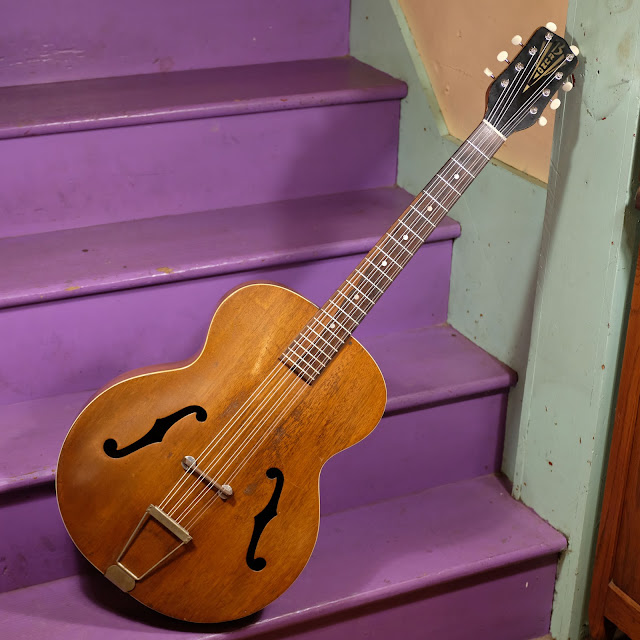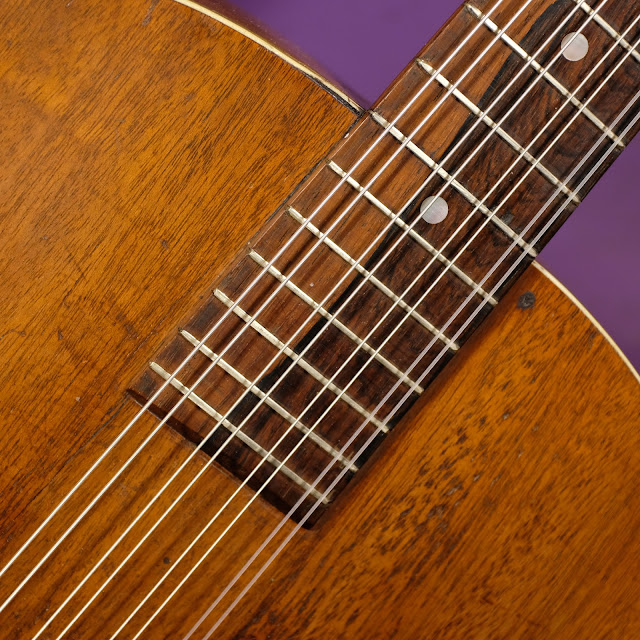1939 Harmony-made Bruno Archtop Nylon-Strung Mandocello Conversion
This began as a traded-in, down-on-its-luck archtop guitar. Someone had botched a neck reset on it and it remained unloved and unrenovated after that. The action was a mile high, of course -- so it sat in my repair racks for a time. I dusted it off the other day, though, and made the trade-deal for it, so now I had to do something with it.
I've wanted to make a nylon-strung mandocello for some time, so I figured this was the perfect rig to do it with. These Harmony-made, all-mahogany archtops (they're press-arched, solid mahogany) often bear Bruno or SS Stewart brands or sometimes have the Harmony Patrician moniker. The ones made early-on in the '30s and '40s are very lightweight and have thinner tops and backs than later ones. They simply sound better because of that. The other materials on them are nice, too -- and they feature mahogany (rather than poplar) necks and Brazilian rosewood fretboards.
Anyhow, it turned-out very well. This has a sweet, mandocello-meets-oud-meets-lute tonality. It also has pretty good volume and the playability and general comfort-level far exceeds the average steel-strung mandocello as the tension is lower and the intonation better due to the string type. One has to play with a lighter touch and more-flexible pick, however, to not over-play it and thwack the strings too hard, though. I used a medium-gauge, flexible nylon pick (of the sort I use on electric guitar) on this in the demo clip rather than my usual Blue Chip picks because of that.
Work included: a neck reset, fret level/dress, replacement (hard-mounted into the body) adjustable bridge, replacement tuners and two extra tuners added to the headstock, replacement (but period) bridge with extra slots for stringing-up 8, cleaning, side dots install, and a setup. The neck is straight and it plays with 3/32" action overall at the 12th fret. The bridge is adjustable to taste, but 3/32" is standard for nylon and feels good. It's strung with two-sets of classical guitar EAD and B strings but I have it tuned, currently, to a modal tuning of DADA using them. I also liked C#G#EbBb with these strings but standard CGDA was too slack on the C&G. A custom set of gauges (heavy-tension low EA classical strings) would solve that problem, though.
Scale length: 25 1/8"
Nut width: 1 3/4"
String spacing at nut: 1 7/16"
String spacing at saddle: 2 1/4"
Nut width: 1 3/4"
String spacing at nut: 1 7/16"
String spacing at saddle: 2 1/4"
Body length: 19 1/8"
Lower bout width: 15 1/4"
Upper bout width: 11"
Lower bout width: 15 1/4"
Upper bout width: 11"
Side depth at endpin: 3 3/8"
Top wood: solid mahogany
Back/sides wood: solid mahogany
Neck wood: mahogany
Fretboard: Brazilian rosewood
Back/sides wood: solid mahogany
Neck wood: mahogany
Fretboard: Brazilian rosewood
Neck shape: 12" radius with medium-to-bigger C/D-shaped rear
Bridge: Brazilian rosewood
Nut: bone (new)
Weight: 3 lb 6 oz (light!)
Condition notes: the bridge is a replacement one I made-up from a same-period Stradolin mandolin bridge top and '60s-era, aluminum electric-guitar thumbwheels. It's hard-mounted into the top. The tailpiece is replacement but period. Tuners are new Kluson-style repros and mounting screws for all the hardware are new, too. The original pickguard is long-gone. My two extra tuners at the headstock are not installed in perfect alignment -- but neither are the original mounting holes. There's only two cracks on the guitar -- one is a 3" hairline crack that's actually covered by the fretboard extension and bracing and thus a non-issue. The other is a tiny hairline next to the heel from some in-the-past neck work. There's plenty of wear-and-tear on the body including discoloration around the heel's edges, pickwear/sweatwear to the finish on the treble-upper-bout, and general handling-wear, nicks, and scratches throughout. The finish is all-original, however, and looks good.
Alien antennae! I've done the same tuner setup before on other giant-headstock guitars. I always feel a little sheepish doing this, but it works so well -- so why not?
The board has pearl face-dots. The frets are pretty low and small but still have some life in them.
An S-39 date-stamp on the inside back and below this bass-side f-hole yields the 1939 dating.
The old "neck reset" work in the past yielded a shimmed-up, split neck block that I had to patch and glue all back into functionality. It's good to go and stable, now, but there's a little mess around its edges.
I love the Gibsonesque, curvy look of Harmony archtops in this period. Harmony would continue to use this "pudgy-sexy" shape through the '50s, but only on certain models by the end of the '50s. It's a great look, I think, with a lot more class and charm than Kay and Regals of similar spec which tended to be more squared and awkward.
Yes, the tailpiece had to move just a little bit to line-up with the string path effectively. The endpin is original, amazingly.


















Comments